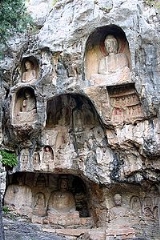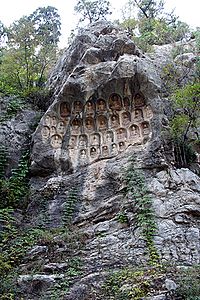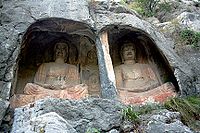
Thousand-Buddha Cliff
Encyclopedia


Tang Dynasty
The Tang Dynasty was an imperial dynasty of China preceded by the Sui Dynasty and followed by the Five Dynasties and Ten Kingdoms Period. It was founded by the Li family, who seized power during the decline and collapse of the Sui Empire...
rock carvings in central Shandong
Shandong
' is a Province located on the eastern coast of the People's Republic of China. Shandong has played a major role in Chinese history from the beginning of Chinese civilization along the lower reaches of the Yellow River and served as a pivotal cultural and religious site for Taoism, Chinese...
Province, China
China
Chinese civilization may refer to:* China for more general discussion of the country.* Chinese culture* Greater China, the transnational community of ethnic Chinese.* History of China* Sinosphere, the area historically affected by Chinese culture...
. Along a cliff face of 63 meters length, over 210 statues and 43 inscriptions have been reported. Most of the statues were carved during 618-684.
Location
The Thousand-Buddha Cliff is located near Liubu Village, in Licheng CountyLicheng County
Licheng County is a county of Shanxi, China. It is under the administration of Changzhi city.-References:*...
, under the administration of Jinan
Jinan
Jinan is the capital of Shandong province in Eastern China. The area of present-day Jinan has played an important role in the history of the region from the earliest beginnings of civilisation and has evolved into a major national administrative, economic, and transportation hub...
City, about 33 kilometers southeast of the city of Jinan proper. It stands immediately to the west of the site of the former Shentong Temple , which is now in ruins. The cliff is oriented in the north-south direction.

History
The first Buddha sculptureBuddharupa
Buddharūpa is the Sanskrit and Pali term used in Buddhism for statues or models of the Buddha.-Commonalities:...
is said to have been carved into the cliff by a 70-year old monk named Sha Dong in the year 619 AD. After a hiatus of 25 years, two more Buddhist sculptures by another old monk named Ming De. Because Ming De felt his live was coming to an end at the time, he also donated money towards the carving of additional statues. However, in the year 657 AD he was still alive and carved more statues and inscriptions into the rock face. Because the official policy during the Tang Dynasty was to encourage conversion to Taoism
Taoism
Taoism refers to a philosophical or religious tradition in which the basic concept is to establish harmony with the Tao , which is the mechanism of everything that exists...
, the carving of Buddhist statues implied a political risk. Hence, the inscriptions left by Sha Dong and Ming De point out that the sole purpose of the statues was prayer and not the expression of political opinions. Despite these difficulties, the work of carving the sculptures into the was continued by other Buddhist and eventually the Thousand-Buddha Cliff became the largest collection of Buddhist cliff statues in Shandong.
Besides the Buddhist sculptures, there are also secular statues depicting nobility such as relatives of the emperor, government officials, and famous monks. Among those are statues of Princess Nanping (南平公主), the daughter of Emperor Taizong of Tang
Emperor Taizong of Tang
Emperor Taizong of Tang , personal name Lǐ Shìmín , was the second emperor of the Tang Dynasty of China, ruling from 626 to 649...
and her husband Liu Xuanyi.
See also
- Thousand Buddha MountainThousand Buddha MountainThe Thousand Buddha Mountain is a hill located southeast of the city of Jinan, the capital of Shandong Province, China. It is renowned for its numerous Buddha images which have been carved out of the hill's rock faces or free-standing structures erect since the times of the Sui Dynasty and its...
(Buddhist site with similar features) - Four-Gates Pagoda (nearby)
- Dragon-and-Tiger PagodaDragon-and-Tiger PagodaThe Dragon-and-Tiger Pagoda is a Tang Dynasty brick and stone pagoda located in central Shandong Province, China. It is considered a characteristic example of the pagoda style of the period.- Location :...
(nearby) - Buddhism in ChinaBuddhism in ChinaChinese Buddhism refers collectively to the various schools of Buddhism that have flourished in China since ancient times. Buddhism has played an enormous role in shaping the mindset of the Chinese people, affecting their aesthetics, politics, literature, philosophy and medicine.At the peak of the...
- Licheng CountyLicheng CountyLicheng County is a county of Shanxi, China. It is under the administration of Changzhi city.-References:*...
- List of sites in Jinan

